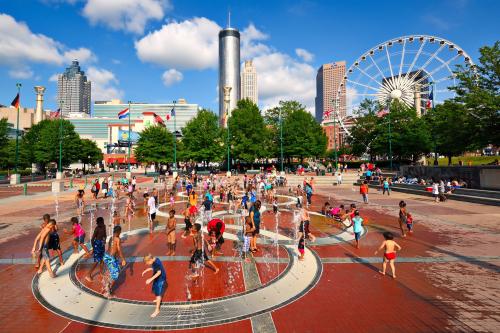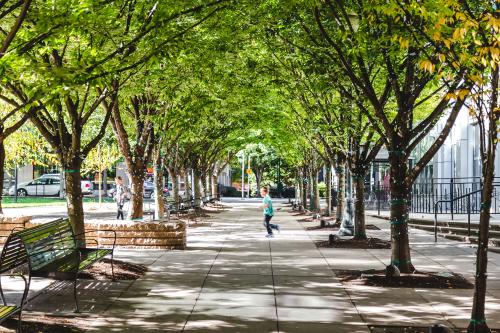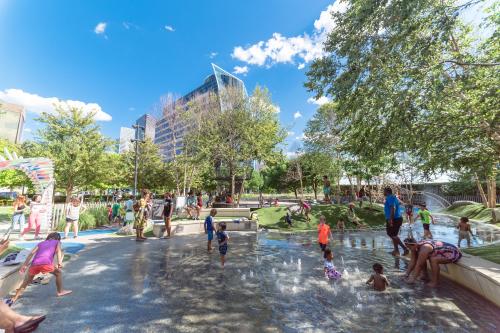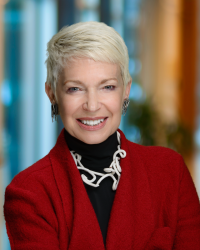Placemaking Postcards is a blog series from the Bass Center for Transformative Placemaking at Brookings where policymakers and practitioners guest-author promising placemaking efforts from across the U.S. and abroad that foster connected, vibrant, and inclusive communities. In line with the principle tenets of placemaking, the goal of the series is to recognize the community as the expert, highlight voices from the field, and to create a community of learning and practice around transformative placemaking.
The storied Mississippi River is at its widest and wildest in Memphis. Rising and falling 55 feet a year, the river is the city’s birth place. It runs alongside the city’s historic downtown, serves as a global hub for trade and transportation, and connects residents to industry and opportunity.
But despite the many economic benefits the river brings, Memphis remains one of the nation’s poorest metropolitan areas, divided by significant racial and socioeconomic disparities. And even with new investments and a real-estate rebirth in the riverfront city, significant barriers remain for Memphians living in high-poverty, segregated, and systematically devalued neighborhoods.
Given these inequities, developers in Memphis must remember that investing in the people of Memphis means investing in a community that is 63% African American. There is no path to success for Memphis that doesn’t lift up black neighborhoods, black businesses, and black people. And building a riverfront city that works for everyone has to be more than a slogan. It’s a mandate.
Toward a riverfront that works for everyone
The most prominent 250 acres of riverfront property are managed by the Memphis River Parks Partnership, a nonprofit that works with and for the people of Memphis to harness the transformative power of the river. In our role as place managers, we’re responsible for cleaning, maintaining, and activating the riverfront. But most importantly, we’re tasked with planning and building a riverfront that brings economic and social gains for all Memphians.
However, we are not an organization funded specifically to pursue equity strategies. Nor are we in the business of property acquisition, housing, or forming land trusts—tactics that have been successfully used to promote equitable development in other places. Instead, we must integrate equity into all that we do, and we must do it within existing financial constraints. Although this can be challenging at times, it means that our equity model can be adopted by almost any organization, in any place.
The model is organized around five major pillars: staff development, contractor development, community engagement and stewardship, connecting adjacent neighborhoods, and free programming for diverse participants. Together, these pillars allow us not only to transform the physical space of the riverfront, but also to leverage its power for transformative gains for the people of Memphis and Shelby County that have been historically excluded from economic growth and development.
- Staff development to advance people and places. Historically, the Partnership did not engage in staff development. Employees in Field Operations–the people who do the hot, hard, and important work of maintaining the riverfront–started at $8.25 an hour, and were siloed, highly specialized, and had little ability to advance into mid-level jobs. In 2018, our new leadership brought big changes, aimed at promoting long-term skill development for all levels of staff. Field Operations employees became generalists, or “Rangers,” who gained responsibility for welcoming and engaging with visitors, in addition to their daily maintenance tasks. Base pay was raised to $13 per hour, new slots were created for advancement to supervisory roles, and all staff were given new tech tools to professionalize and routinize fieldwork. With these new organizational responsibilities, employees embraced their responsibility to create an elevated experience on the riverfront—one where people mix across social, economic, and neighborhood divides, and where all Memphians feel more welcomed and valued
- Contractor development to support minority- and women-owned businesses. In the last 18 months, we made supporting minority- and women-owned business enterprises (MWBEs) a critical component of our development strategy, achieving a total 44% participation for contractor development. One of the projects–the conversion of Jefferson Davis Park to River Garden—used new landscaping methods and park elements that positioned the contractor to take on larger projects planned for the riverfront next year. In addition, the Partnership has committed between 38 and 66% of its operating budget each quarter to MWBE spending, solidifying MWBE support as a key aspect of our work moving forward.
- Community engagement and stewardship to shape the direction of the space. We believe in the importance of inviting community members in, not just as consumers, but as shapers and stewards of the riverfront. In River Garden, local elementary, middle, and high school students designed, prototyped, and built three life-sized “bird nests” crafted from Mississippi River driftwood for the space. The next big riverfront park transformation, the new Tom Lee Park, has high school students from core-city neighborhoods working alongside the design team, enabling them to gain resume-building skills and providing valuable insight on the park’s future. Additionally, the Partnership has recruited more than 70 community members to serve as riverfront ambassadors who volunteer at events, participate in service projects, and donate and raise money to support the riverfront.
- Connecting adjacent neighborhoods to increase opportunity across districts. The benefits of connecting the riverfront to disadvantaged neighborhoods to the north, south, and east of downtown are clear. However, both physical and symbolic barriers still prevent the riverfront from being enjoyed by all Memphians. Such barriers include a steep bluff separating downtown from the water, traffic moving along the riverfront at high speed, and single-family homes along the bluff that can make visitors feel that they are intruding. There are also symbolic boundaries around downtown that exist mostly in the minds of Memphians—but that are rooted in deep historical inequities dividing the city. While mitigating some of these barriers would require significant physical, historical, and legal changes, the Partnership is working to eliminate or minimize those that it can. In particular, we are leading efforts to define pedestrian and cycling corridors between the riverfront and surrounding neighborhoods, as well as bring attention to the long-overlooked MLK Park south of downtown, to use as an anchor for new investment in the adjacent neighborhood.
- Free programming to bring together diverse neighbors. By focusing on programs with low or non-existent barriers to entry—such as yoga classes, salsa dancing, roller-skating, basketball, and concerts—we have drawn a racially and economically diverse audience to the riverfront. With free kayak rentals and lessons available on the riverfront every day, Memphians without access to boats can see the city from the water for the first time.
Each of these actions may seem modest in isolation. But together, they are redefining the way we approach our work, day in and day out. Questions of equity and inclusion are always present, both in the operation of the enterprise and in the riverfront we are attempting to create. Creating a riverfront that works for everyone, every day, is the only way to achieve our mission of harnessing the transformative power of the river for all Memphians.
Image credit: Selavie Photography







Commentary
How Memphis, Tennessee is transforming the city through its riverfront
August 21, 2019